Nakajima Ki 84 Hayate (early)
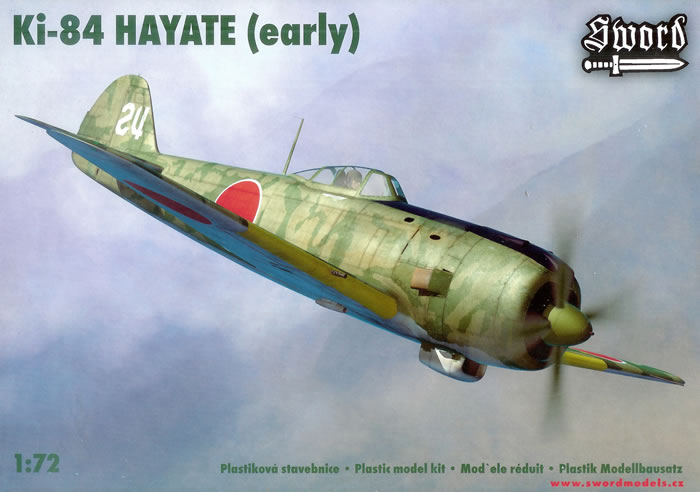
Sword, 1/72 scale
S u m m a r y : |
Catalogue Number: |
Sword Kit No. SW72032 - Nakajima Ki 84 Hayate (early) |
Scale: |
1/72 |
Contents & Media: |
45 x grey styrene, 4 x clear styrene, 6 x resin parts, and decals for two subjects |
Price: |
Available online from Hannants for £12.76, Squadron for UDS$26.96, and Modelimex for €14.58 |
Review Type: |
First Look. |
Advantages: |
Good quality mouldings, fine panel lines and good detail levels for the scale. Looks to be a straight-forward build. |
Disadvantages: |
A resin seat with belts would have been nice. |
Conclusions: |
An excellent kit of an attractive subject. |
Reviewed by
Mark Davies

HyperScale is proudly sponsored by
Squadron.com
Background
Japanese fighter design in the late 1930’s placed great emphasis on manoeuvrability. This was achieved with fighters that often had modest power and armament, and at the expense of armour protection and self-sealing fuel tanks. Nakajima had been a prime supplier of fighters to The Imperial Japanese Army Air Force (IJAAF), and its very nimble Ki 43 Hayabusa was well received, as it met the prevailing Japanese fighter design philosophy admirably. However Nakajima recognised the benefits of a more powerful and better-protected fighter, like their Ki 44 Shoki, but that still retained high manoeuvrability like the Ki 43 and a good climb rate. They undertook design work on a heavy fighter powered by a 2,000 hp, and after sharing this with the IJAAF an order for development was placed in May 1942.
Following a remarkably short development time the prototype of the Ki 84 first flew in April 1943. By this mid-war period big powerfully armed and protected American fighters had begun to take a heavy toll of lighter Japanese types. So the IJAAF’s need for a fighter with similar characteristics and capabilities as the US opposition was pressing indeed. Nakajima was instructed to rush the Ki 84 into production. Between August 1943 and March 1944 83 evaluation aircraft were tested. This included some operational testing from October 1943, with the first operational unit being formed in March 1944. A further 42 evaluation aircraft were produced, and in April 1944 mass production was ordered as Ki 43 production ceased.
By this time the Allies completely dominated the air. The desperate need for a fighter capable of competing with US types on equal terms had gone largely unfulfilled for some time. In theory the Ki 84 offered what was needed, but all too often other pressures from Japan being on the back-foot by this stage of the war affected its combat success. Primary amongst these were the loss of experienced pilots and the use of poorly trained replacements. Also material shortages and quality control impacted reliability, especially that of the Ha-45 engine, which frequently failed to deliver design power levels. Maintenance difficulties in the field just added to these woes. And so one of japan’s best fighters was unable to live up to its full promise, despite in theory being equal to, and in some areas better, than its adversaries.
Over 3,000 Ki 84’s were built (I’ve read of figures ranging from 3,200 to just over 3,500). In addition to the IJAAF, a few Hayate’s were operated by both communist and nationalist Chinese air forces, and also by Indonesia.
Previous 1/72 Hayates
I am aware of four previous Ki 84 kits in 1/72 scale. Revell issued one in the 1960’s, and I believe both Fujimi & Tamiya released kits in the early 1970’s. I have a feeling Tamiya’s kit may have been 1/75. All of these kits are of more collectable than buildable interest I should think, and are not commonly seen. There may also have been a kit by Aoshima, but I’m guessing more than remembering. The best of the four older kits is Hasegawa’s, which although one of their earlier fine raised detail issues, is very nice and builds well. It is readily available having been re-boxed by Hasegawa many times, as is their wont. However, a more modern kit with enhanced detail and offering different versions is still very welcome. Sword released the first of its Ki-84 kits in 2008, so no doubt some readers will have already experienced this kit.
The kit comes in a typically Czech end-opening box with attractive artwork on the front. The instructions provide a parts map, and easy to follow diagrammatic assembly format. There is also a brief history of the aircraft. Text is in Czech and English. Painting and decal guides are quite adequate black & white shaded 4-view drawings. Generic colour call outs are provided for detail parts and Nakajima paint names for the airframe.
I have numerous Sword kits, and this one is quite typical of the brand in that the plastic has a more shiny finish than many other Czech limited run brands. All parts are cleanly moulded with very fine surface detail, parts break down is conventional, and the sprue gates are narrow. Just a little flash is visible in places but will be easily dealt with. The resin parts are also produced to high standards.
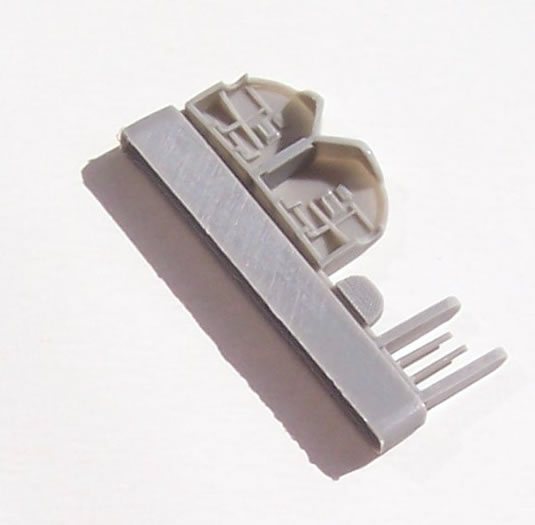
Internal detail is moulded on the cockpit sidewalls. The instrument panel and overall cockpit detail is quite good for the scale, and captures the look of the original. However there are no seat belts. It’s a pity as a seat harness would likely be one of the most visible things through the small cockpit opening. This is a small criticism however.
The resin parts include a very nicely cast engine, a wheel-well insert, cannon barrels and oil-cooler matrix.
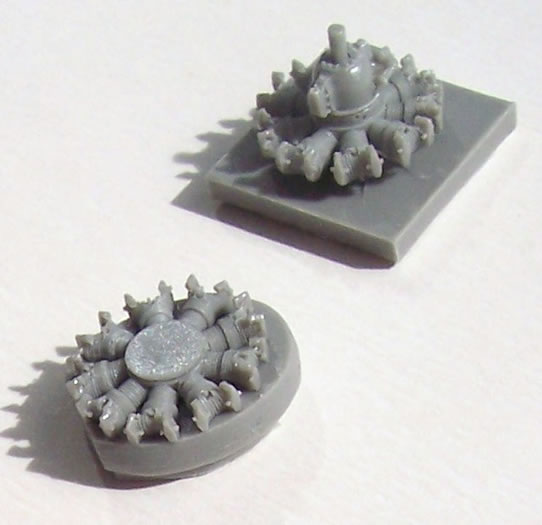
The clear canopy is injected and comes as both a single-piece closed item, or in three pieces for open display. Both are quite thin in section.
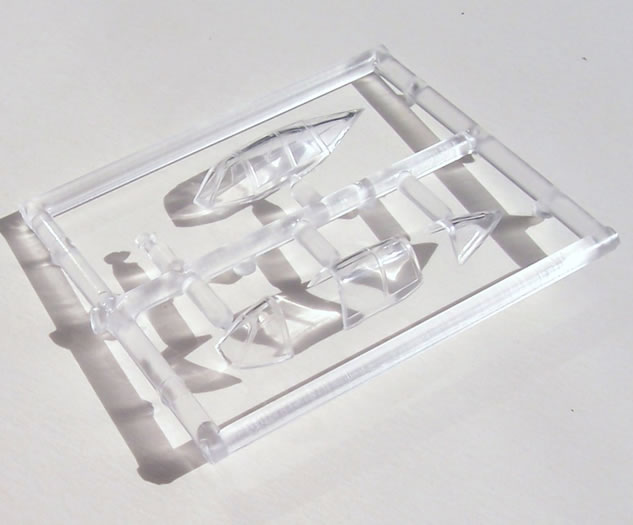
The tooling has been designed to cover several versions with inserts for different cowl flaps and exhausts, different upper cowl sections depending on gun blast-tube style, and two rudder styles. This boxing has a separate sprue providing the early version components. Construction sequence and parts breakdown is conventional for the type, and the kit looks as if it should be a very straightforward build.
Two decal options are for a bare metal or a camouflaged aircraft.
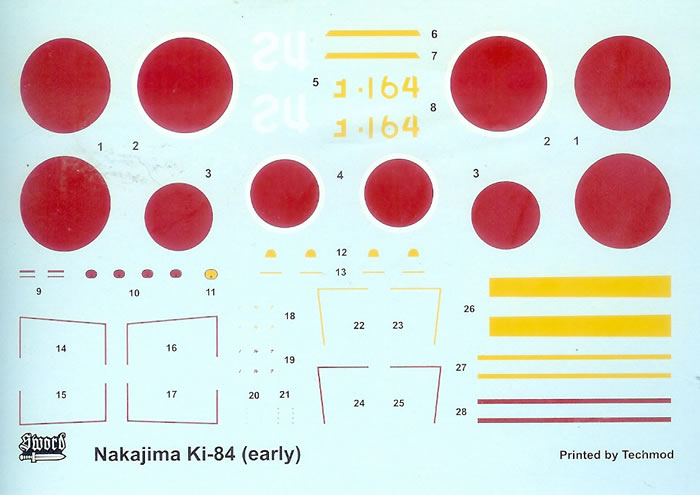
Decals look to be well registered with good opacity.
This is a nicely engineered kit that is produced to high standards. It looks to be a simple build with the potential to produce a good model of a very attractive Japanese fighter.
Highly recommended.
Thanks to Sword Models for this review sample.
Review Text & Images Copyright © 2010 by Mark Davies
Page Created 31 August, 2010
Last updated
31 August, 2010
Back to HyperScale Main Page

|
